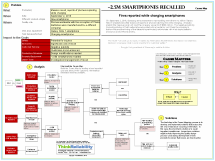 On September 2, 2016, Samsung announced that it was recalling more than two million Galaxy Note 7 smartphones after dozens of reports of phones catching fire while charging. Analysts predict the massive recall will cost the company upwards of $900 million. The negative publicity (including photos of half-melted phones posted online) certainly won’t help the company’s bottom line and the timing of the debacle is particularly unfortunate with rival Apple slated to announce a new iPhone shortly. The Federal Aviation Administration is also asking travelers not to check or use Galaxy Note 7 smartphones during flights which will not improve customer confidence.
On September 2, 2016, Samsung announced that it was recalling more than two million Galaxy Note 7 smartphones after dozens of reports of phones catching fire while charging. Analysts predict the massive recall will cost the company upwards of $900 million. The negative publicity (including photos of half-melted phones posted online) certainly won’t help the company’s bottom line and the timing of the debacle is particularly unfortunate with rival Apple slated to announce a new iPhone shortly. The Federal Aviation Administration is also asking travelers not to check or use Galaxy Note 7 smartphones during flights which will not improve customer confidence.
So what is causing these smartphones to catch fire? Statements by the company have indicated that there were issues with the batteries, not the cellphones themselves. The phones use rechargeable lithium-ion batteries that are lightweight and long-lasting. Lithium-ion batteries contain combustible components separated by ultra-thin walls. When the separators fail and combustible components contact each other a large amount of heat can be released, potentially causing fires and even explosions.
The company hasn’t released information on the specifics of what type of failure occurred inside the batteries, stating only that there was a flaw in the manufacturing process and that the quality controls in place were inadequate to identify the flaw. It is estimated that about 1 in 42,000 units may have a faulty battery.
A Cause Map, a visual root cause analysis format, can be built to help understand this issue. All the causes that contributed to an issue are visually laid out to show the cause-and-effect relationships. Most issues have more than one cause and focusing on all the causes, rather than a single “root cause”, will naturally expand the solutions considered. To view an intermediate Cause Map of this issue, click on the graphic above.
The final step in the Cause Mapping process is to develop and implement solutions. In this example, recalling the smartphones helps reduce the risk of the immediate issue of smartphones catching fire, but the company will likely also want to implement longer-term solutions to prevent similar issues with all their phones in the future. A thorough investigation would need to look into the quality controls in place to ensure they are adequate and work to understand exactly why the issues with battery cells occurred. If a Cause Map was being used to perform the actual investigation, more detail would need to be added so that the problem was thoroughly understood and that useful, specific longer-term solutions could be developed.
If you happen to own a Samsung Galaxy Note 7, you can get more information here. Samsung has also released an update that address the issue by limiting the battery charge to 60%, which is an annoying short term”fix” but should help prevent overheating.


![Document Your Root Cause Analysis Investigation Like a Pro [Download the Free Template]](https://hubspot-no-cache-na2-prod.s3.amazonaws.com/cta/default/2164270/8df3876c-a4ed-43bf-b6cc-e53f59a6f21a.png)








